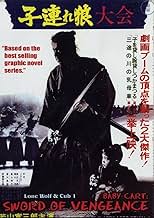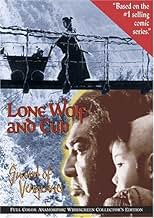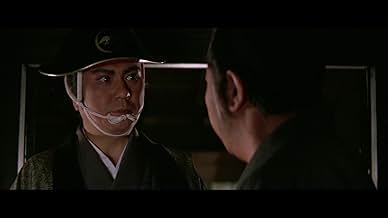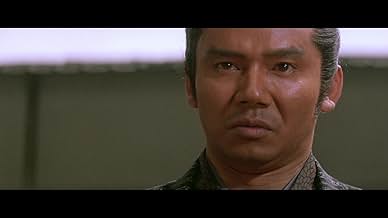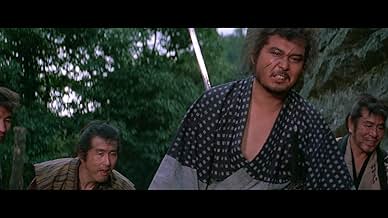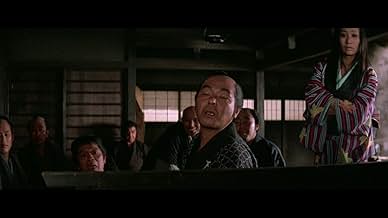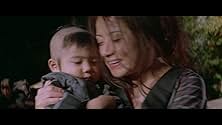Lobo Solitário - A Espada da Vingança
Título original: Kozure Ôkami: Ko o kashi ude kashi tsukamatsuru
AVALIAÇÃO DA IMDb
7,7/10
9,4 mil
SUA AVALIAÇÃO
Adicionar um enredo no seu idiomaThe story of a Ronin (i.e. a masterless samurai) who wanders the countryside of Japan with his small child, having various adventures.The story of a Ronin (i.e. a masterless samurai) who wanders the countryside of Japan with his small child, having various adventures.The story of a Ronin (i.e. a masterless samurai) who wanders the countryside of Japan with his small child, having various adventures.
- Direção
- Roteiristas
- Artistas
Avaliações em destaque
10jolgo13
The first entry in a series of master pieces. Based very strongly upon the manga series `Lone Wolf and Cub' is most likely the best film series derived from comics. And truly great films as well. One cannot base one story on a single comic. There are so many elements in each. There is a basic story, but often times there are mixed with others. Little things are thrown in as well. Normally it would make any less a film seem crammed or just forced in. But it is pulled off brilliantly.
This film, the first entry is largely a set up for the sequels but still brilliant, from its beautiful camera shots to the extremely gory ascetic fights. It tells the story of how the main character Ogami Itto was exiled from his royal position as the Shoguns decapitator. It flashes from past to present until the entire past story is told. The ending fight is a great climax.
The sword work although at times seems fake is brilliantly choreographed. The gore in the film is not overly done, but rather thrown in to give it an artistic feel, as if you're watching a moving painting. Often times one may think every scene could very well be a panting.
Some aspects of the plot may seem odd to most western audiences. The scene where Ogami gives his son a choice between a ball and a sword. Or rather life or death, may strike many people as cold. However one must understand bushido and know that the way of the samurai is life in death. Ask yourself what would be worse taking your son on a trip as you kill men beyond number, or giving somewhat of a choice.
This film is truly beautiful, and hold up today as not just one of the greatest samurai films ever made, but films period.
This film, the first entry is largely a set up for the sequels but still brilliant, from its beautiful camera shots to the extremely gory ascetic fights. It tells the story of how the main character Ogami Itto was exiled from his royal position as the Shoguns decapitator. It flashes from past to present until the entire past story is told. The ending fight is a great climax.
The sword work although at times seems fake is brilliantly choreographed. The gore in the film is not overly done, but rather thrown in to give it an artistic feel, as if you're watching a moving painting. Often times one may think every scene could very well be a panting.
Some aspects of the plot may seem odd to most western audiences. The scene where Ogami gives his son a choice between a ball and a sword. Or rather life or death, may strike many people as cold. However one must understand bushido and know that the way of the samurai is life in death. Ask yourself what would be worse taking your son on a trip as you kill men beyond number, or giving somewhat of a choice.
This film is truly beautiful, and hold up today as not just one of the greatest samurai films ever made, but films period.
Like many fans, my first exposure to the world of badass warrior Ogami Itto (and son) was through Shogun Assassin, an infamous 'video nasty' that was compiled from the 'best bits' of the first two movies in the Baby Cart series, 'Sword Of Vengeance' & 'Baby Cart At The River Styx. A stylish blood-drenched epic, Shogun Assassin piqued my interest enough to make me seek out the entire Baby Cart series (comprising of six films, made between 1972 and 1974).
Sword of Vengeance introduces us to protagonist Itto (Tomisaburo Wakayama), whose job, as Second for the Shogunate, is to execute the enemies of the Shogun, should they fail to commit seppuku (ritual suicide). After his wife is murdered, Itto is framed for treason by the nasty Yagyu clan (who wish to take his coveted position as Second). Now a Ronina samurai without a master he takes to the road working as an assassin for hire, accompanied by his young son Daigoro, who rides in a booby-trapped wooden cart. Together, they are known as Lone Wolf and Cub.
With superbly choreographed fight scenes, wonderful cinematography, a terrific soundtrack, and a great central performance from Wakayama, this is an unmissable piece of samurai cinema. Itto is the Japanese equivalent of Clint Eastwood's 'man with no name': a cool-headed, tough-as-nails, and honourable character who is sparing with his words, and who only acts with violence when necessary (but always with devastating results).
A lethal force with his sword (and also with the variety of weapons secreted about Daigoro's cart), Itto cuts a swathe through all who are stupid enough to challenge him. A quick flash of his blade, and his enemies are either minus a limb or two, or spouting a geyser of blood from a fatal wound.
Sword of Vengeance is a prime example of cool, gritty and stylish 70s cult cinema. Watch it, and be cool by association.
Sword of Vengeance introduces us to protagonist Itto (Tomisaburo Wakayama), whose job, as Second for the Shogunate, is to execute the enemies of the Shogun, should they fail to commit seppuku (ritual suicide). After his wife is murdered, Itto is framed for treason by the nasty Yagyu clan (who wish to take his coveted position as Second). Now a Ronina samurai without a master he takes to the road working as an assassin for hire, accompanied by his young son Daigoro, who rides in a booby-trapped wooden cart. Together, they are known as Lone Wolf and Cub.
With superbly choreographed fight scenes, wonderful cinematography, a terrific soundtrack, and a great central performance from Wakayama, this is an unmissable piece of samurai cinema. Itto is the Japanese equivalent of Clint Eastwood's 'man with no name': a cool-headed, tough-as-nails, and honourable character who is sparing with his words, and who only acts with violence when necessary (but always with devastating results).
A lethal force with his sword (and also with the variety of weapons secreted about Daigoro's cart), Itto cuts a swathe through all who are stupid enough to challenge him. A quick flash of his blade, and his enemies are either minus a limb or two, or spouting a geyser of blood from a fatal wound.
Sword of Vengeance is a prime example of cool, gritty and stylish 70s cult cinema. Watch it, and be cool by association.
Tomisaburo Wakayama is Lone Wolf and Akihiro Tomikawa is Cub, his three-year-old son. Together they wander around Japan, the youngster in a baby carriage with a sign noting that child and expertise are for hire. It turns out, via a long flashback, that he used to be the executioner for the Shogun. Then the evil Yagyu seized that office and he was supposed to kill himself. So he went rogue and is now wandering around Japan, dealing with prostitutes, madwomen, thieves and the occasional Yagyu ninja.
Anyway, in this one, he trundles Cub to a hot spring for a vacation. It's run by desperate criminals who try to intimidate him. They don't. Eventually, we can be assured, assassins will show up and there will be a colorful bloodbath.
For people who like lots of fake blood amidst some great cinematography, and Japanese acting stoically bizarre, it's just what the audience ordered.
Anyway, in this one, he trundles Cub to a hot spring for a vacation. It's run by desperate criminals who try to intimidate him. They don't. Eventually, we can be assured, assassins will show up and there will be a colorful bloodbath.
For people who like lots of fake blood amidst some great cinematography, and Japanese acting stoically bizarre, it's just what the audience ordered.
My knowledge in Japanese samurai films is a bit narrow, but I'll take the chance to draw a parallelism between east and west cinema that could sound blasphemous or stupid to somebody who knows more about it. But I suppose, if westerns had John Ford as a traditionalist filmmaker and Sergio Leone as a revolutioner who shattered that sanitized and mythic image and made it dirty and unheroic, I could apply that same logic to samurai films of Akira Kurosawa and then to what Kenji Misumi accomplished in this first chapter. I guess that shallow explanation could serve a newcomer to picture what kind of brilliant and bloody action film they'll find here. also judging from the bloody fight scenes its clear where Tarantino got his influence for his Kill Bill films.
Sword of Vengeance is the first film in a series about a noble samurai and his son fallen from grace through a conspiracy, and now under a constant fear of death by assassination. This movie by itself is a fine example of how a more modern, 'slasher' style Samurai film and 'old' values like honor and '1-good-Samurai-defeats-army-of-bad-Samurai' can be put together to make a solid, entertaining film. The later films are sometimes better, sometimes worse than this movie, but I found all of them to be very entertaining and worthwhile.
If you like to see some classic Samurai action, check out the whole serie of six films. Years later they took all the juicy bits out of the first four films and stitched them together to form the film 'Shogun Assassin', a film I suspect made for export to western countries: Less story, more blood.
If you like to see some classic Samurai action, check out the whole serie of six films. Years later they took all the juicy bits out of the first four films and stitched them together to form the film 'Shogun Assassin', a film I suspect made for export to western countries: Less story, more blood.
Você sabia?
- CuriosidadesAkihiro Tomikawa, who portrays Ogami Itto's son, Daigoro, only ever played this one character for his on-screen acting career. He appears as Daigoro in all six 'Lone Wolf & Cub' feature films, and then in 1980's 'Shogun Assassin', which is recut footage from the first two films in the series.
- Erros de gravaçãoAfter disposing of the ronin on the village, Ogami collects Daigoro, places him the cart and leaves the village. He is not seen to re-assemble the hidden weaponry in the cart.
- Citações
Ogami Itto: You would've been happier if you'd chosen to join your mother in her world.
- Versões alternativasThe 1999 UK video was cut by 6 secs by the BBFC to edit a scene where a woman is stripped topless, and the Artsmagic DVD featured the same print. The 2009 Eureka release (featured in the "Lone Wolf & Cub Collection") is fully uncut.
- ConexõesEdited into Ninja Assassino (1980)
Principais escolhas
Faça login para avaliar e ver a lista de recomendações personalizadas
- How long is Lone Wolf and Cub: Sword of Vengeance?Fornecido pela Alexa
Detalhes
- Data de lançamento
- País de origem
- Idioma
- Também conhecido como
- Lone Wolf and Cub: Sword of Vengeance
- Locações de filme
- Empresas de produção
- Consulte mais créditos da empresa na IMDbPro
Contribua para esta página
Sugerir uma alteração ou adicionar conteúdo ausente

Principal brecha
By what name was Lobo Solitário - A Espada da Vingança (1972) officially released in India in English?
Responda

